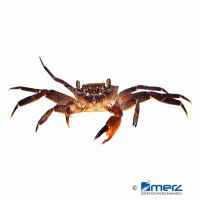Gold Leg Matano Crab (Parathelphusa ferruginea)
| Gold Leg Matano Crab Parathelphusa ferruginea | |
|---|---|
| Name | Gold Leg Matano Crab |
| Name Lat. | Parathelphusa ferruginea |
| Synonym | Syntripsa ferruginea |
| Family | Gecarcinucids |
| Family lat. | Gecarcinucidae |
| Order | Decapoda |
| Order lat. | Decapoda |
| Origin | Sulawesi |
| Habitat | Lakes, tributaries |
| Diet | Algae, snails, crab food |
| pH | 7.5-8.5 |
| Behavior | Predatory |
| Keeping | Pair, group |
| Care Level | Moderate |
| Reproduction | Oviparous |
| Breeding | None reported |
| Life Span | 3-5 years |
| Protection | No |
| Metric Units | |
| Size | 8-10 cm |
| Temperature | 22-28 °C |
| Hardness | 8-12 °dH |
| Aquarium | 100 l |
| US Units | |
| Size | 3.1"-3.9" |
| Temperature | 72-82 °F |
| Hardness | 142-214 ppm |
| Aquarium | 25 gal |
Distribution and habitat
The purely aquatic Rusty Brown Sulawesi Crab is found in Lake Towuti and Lake Mahalona on the island of Sulawesi, Indonesia. They mainly reside in the areas close to the shore, with soft, leaf-covered substrate.
Maintenance
They need a well structured aquarium with roots, stones and some plants as well as numerous hiding places (caves, perforated rocks, crab tubes, coconut shell). A dark substrate of sand or fine gravel covered with some foliage (e.g. sea almond tree, oak), some shaded light (floating plants) and slightly alkaline water is ideal.
No ammonia, ammonium and nitrite should be detectable in the water. The nitrate value should be below 50 mg/l. When choosing a filter, care should be taken to provide moderate water flow and to prevent animals from entering the filter. The lighting should correspond to the natural day-night rhythm of the animals.
Diet
The food supply consists of live, frozen and dry food. For a balanced diet, feed once a day with a high-quality dry food for crabs (granules, pellets, tablets), as well as with artemia and mosquito larvae (live or frozen). In addition, they regularly need some vegetable food, such as algae leaves or dry food with vegetable ingredients (e.g. Spirunia)
Unaccepted food must be removed after 4-5 hours. Regular and varied feeding promotes health and prevents deficiency symptoms.
Behaviour and compatibility
It is recommended to keep them in pairs or in a group in a species tank. Keeping a group is only possible in a much larger, richly structured tank. A socialization with fish, such as rainbow fish or barbs is well possible. Fish that are too small, or very slow swimming, may be considered prey. Keeping them together with shrimps is usually possible without any problems. In principle, only mutually compatible species with similar demands on water conditions and water temperature may be socialized.
Reproduction and breeding
There are no known reports of successful breeding in the aquarium.
Important
It is an aquatic-only (aquatile) crab species that does not require a land part.
Three different color forms are known with yellow, purple and rusty brown legs.
Each crab must have at least one cave of its own where it can hide and where it can also molt without disturbance.
The aquarium must be well covered or the water level lowered appropriately to prevent them from escaping.
The well-being of the animals should be checked regularly. The temperature should be checked daily, the pH, hardness and nitrate value at least every 14 days. Regular partial water changes are recommended, even if the contaminant level has not yet reached the upper limit. Sudden changes in water quality should be avoided. Newly introduced animals must be accustomed slowly to the water in the aquarium.
Further literature can be found in your pet store.
References
Text: petdata; Image: Merz Zierfischgroßhandel
Source: ENGELMANN & LANGE (2011): Zootierhaltung - Tiere in menschlicher Obhut: Wirbellose, Verlag Harri Deutsch
